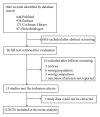Intensive insulin therapy for septic patients: a meta-analysis of randomized controlled trials
- PMID: 25136614
- PMCID: PMC4086473
- DOI: 10.1155/2014/698265
Intensive insulin therapy for septic patients: a meta-analysis of randomized controlled trials
Abstract
Background. Studies on the effect of intensive insulin therapy (IIT) in septic patients with hyperglycemia have given inconsistent results. The primary purpose of this meta-analysis was to evaluate whether it is effective in reducing mortality. Methods. We searched PubMed, Embase, the Cochrane Library, clinicaltrials.gov, and relevant reference lists up to September 2013 and including randomized controlled trials that compared IIT with conventional glucose management in septic patients. Study quality was assessed using the Cochrane Risk of Bias Tool. And our primary outcome measure was pooled in the random effects model. Results. We identified twelve randomized controlled trials involving 4100 patients. Meta-analysis showed that IIT did not reduce any of the outcomes: overall mortality (risk ratio [RR] = 0.98, 95% CI [0.85, 1.15], P = 0.84), 28-day mortality (RR = 0.66, 95% CI [0.40, 1.10], P = 0.11), 90-day mortality (RR = 1.10, 95% CI [0.97, 1.26], P = 0.13), ICU mortality (RR = 0.94, 95% CI [0.77, 1.14], P = 0.52), hospital mortality (RR = 0.98, 95% CI [0.86, 1.11], P = 0.71), severity of illness, and length of ICU stay. Conversely, the incidence of hypoglycemia was markedly higher in the IIT (RR = 2.93, 95% CI [1.69, 5.06], P = 0.0001). Conclusions. For patients with sepsis, IIT and conservative glucose management show similar efficacy, but ITT is associated with a higher incidence of hypoglycemia.
Figures





References
-
- Angus DC, Linde-Zwirble WT, Lidicker J, Clermont G, Carcillo J, Pinsky MR. Epidemiology of severe sepsis in the United States: analysis of incidence, outcome, and associated costs of care. Critical Care Medicine. 2001;29(7):1303–1310. - PubMed
-
- Kumar G, Kumar N, Taneja A, et al. Nationwide trends of severe sepsis in the 21st century (2000–2007) Chest. 2011;140(5):1223–1231. - PubMed
-
- Taylor JH, Beilman GJ. Hyperglycemia in the intensive care unit: no longer just a marker of illness severity. Surgical Infections. 2005;6(2):233–245. - PubMed
-
- Inzucchi SE. Management of hyperglycemia in the hospital setting. The New England Journal of Medicine. 2006;355(18):1903–1911. - PubMed
-
- Krinsley JS. Association between hyperglycemia and increased hospital mortality in a heterogeneous population of critically ill patients. Mayo Clinic Proceedings. 2003;78(12):1471–1478. - PubMed
Publication types
MeSH terms
Substances
LinkOut - more resources
Full Text Sources
Other Literature Sources
Medical

